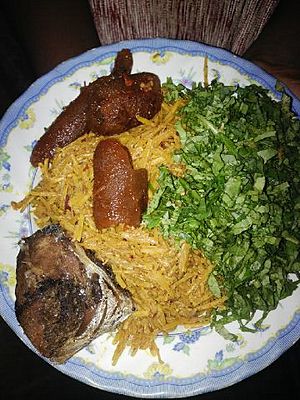Abacha (food) facts for kids

Abacha with kpomo, fish and utazi
|
|||||||
| Alternative names | African Salad | ||||||
|---|---|---|---|---|---|---|---|
| Place of origin | |||||||
| Region or state | South East | ||||||
| Serving temperature | Cold | ||||||
| Main ingredients | Dried shredded cassava | ||||||
| Ingredients generally used | Ogiri | ||||||
| Variations | Ukpa, Ugba | ||||||
| 367 kcal (1537 kJ) | |||||||
|
|||||||
Abacha is a super popular and yummy dish from Nigeria, especially loved by the Igbo people in the country's southeastern part. It's often called "African Salad" because it's usually served cold and has lots of fresh ingredients. This special meal is a big part of celebrations and family gatherings!
What is Abacha?
Abacha is a traditional meal that comes from the Igbo tribe in southeastern Nigeria. It's made mainly from dried, shredded cassava. Cassava is a root vegetable, a bit like a potato, that's very common in many parts of Africa. For Abacha, the cassava is cooked, shredded, and then dried. This makes it ready to be turned into the delicious "African Salad."
Key Ingredients
Abacha gets its amazing taste from a mix of fresh and flavorful ingredients. Here are some of the main things that go into making this dish:
- Dried shredded cassava: This is the main part of Abacha. It's what makes the "salad" base.
- Ugba or ukpaka: These are fermented oil bean seeds. They add a unique, rich flavor to the dish.
- Palm oil: This bright red oil gives Abacha its signature color and a special taste.
- Powdered potash: This helps to mix the oil and other ingredients into a smooth sauce.
- Fish: Often, spiced and cooked fish is added for extra protein and flavor.
- Ponmo: This is cooked and sliced cow skin, a popular addition in Nigerian dishes.
- Onion: Sliced onions add a fresh, sharp taste.
- Garden eggs: These small, round vegetables are diced and mixed in.
- Garden egg leaves: Chopped leaves from the garden egg plant add a fresh, green touch.
- Salt and dry pepper: These are used to season the dish to perfection.
- Crayfish: Ground crayfish gives a deep, seafood flavor.
- Seasoning cubes: These help to boost the overall taste.
- Calabash nutmeg: A spice that adds a warm, nutty aroma.
- Ogiri: Another fermented ingredient, often made from castor seeds, for a strong, traditional flavor.
- Fresh utazi leaves: These leaves have a slightly bitter taste that balances the richness of the dish.
How Abacha is Made
Making Abacha is a fun process, though it has a few steps. Here's a simplified way it's prepared: 1. Soaking the Cassava: First, the dried shredded cassava is put into a bowl of water. It soaks for about 40 minutes until it becomes soft. Then, the water is drained away. 2. Preparing the Sauce: While the cassava soaks, other ingredients are prepared. Fish is fried, and ponmo is boiled. In a separate pot, palm oil is mixed with warm water and powdered potash. This creates a thick, yellow paste. 3. Mixing the Flavors: Once the yellow paste is ready, lots of spices and ingredients are added. This includes sliced onions, pepper, ugba, and diced garden eggs. Everything is mixed well to combine the flavors. 4. Combining and Serving: Finally, the soaked cassava is added to the flavorful sauce and mixed thoroughly. The cooked fish, ponmo, and fresh utazi leaves are often added at this stage. Abacha is usually served and enjoyed while it's still warm or at room temperature.
When is Abacha Eaten?
Abacha is more than just a meal; it's a dish that brings people together. It's very popular during special times like the New Yam Festival, which celebrates the harvest of new yams. It's also a common dish served at marriage ceremonies and other big family events. It's a dish that truly represents the rich culture and hospitality of the Igbo people.

